Saturday, November 25, 2017 – 09:51We will be undertaking a 19-day field effort off O‘ahu starting November 2nd, funded through a NOAA Species Recovery Grant to the State of Hawai‘i. This will be our first field effort off O‘ahu this year (our last was in October 2016). Our primary goal is to find and learn more about the endangered main Hawaiian Islands population of false killer whales. We will be based out of Ko Olina Marina and primarily working off the Wai‘anae coast. We are hoping to deploy LIMPET satellite tags to track movements, as well as photo-identify individuals and collect biopsy samples for genetics, hormone chemistry and toxicology. As usual, we’ll be working with all species of odontocetes we encounter, trying to obtain photos for our photo-identification catalogs, as well as collect biopsy samples for other studies. The research crew for this project will include Daniel Webster, Kim Wood, Colin Cornforth and Robin Baird, all from Cascadia, as well as a number of volunteers.
End of project update
Over the 19 days of this project we covered over 1,900 km off the west side of O‘ahu, had 50 encounters with 10 species of odontocetes and took over 52,000 photos, collected six biopsy samples (of two species), and four squid samples, as well as deployed three satellite tags. Overall a very successful project! Our most frequently encountered species were pantropical spotted dolphins (14 sightings) and short-finned pilot whales (11 sightings). Tied for the 3rd spot were rough-toothed dolphins and false killer whales (six sightings each), but in the case of the false killer whales the satellite tag deployed during our first sighting helped us re-locate the group on all the subsequent sightings, so the high number of sightings is a bit misleading. Probably the most unusual sighting of the trip was actually a small group of Cuvier’s beaked whales seen on November 18th south of Honolulu – in our 83 days of effort off O‘ahu over the years (2002, 2003, 2010, 2015, 2016, 2017), covering over 9,000 km of search effort, this is our first sighting of Cuvier’s beaked whales off the island!

Also on November 18th we had our 6th (and final) sighting of false killer whales for the trip, spread out over a wide area south of Honolulu. We deployed another satellite tag on the group, collected another biopsy sample, and witnessed five different fish chases (four mahimahi and one ono). One of the fish attacks (one a large mahimahi) was one of the longest we’ve witnessed, lasting about 40 minutes, primarily because the fish had a good place to hide, around a floating barrel. Three different individual whales spent time trying to separate the fish from the barrel and were eventually successful, in the process leaping repeated around the barrel trying to hit or grab the mahi. Some additional photos of this encounter below.
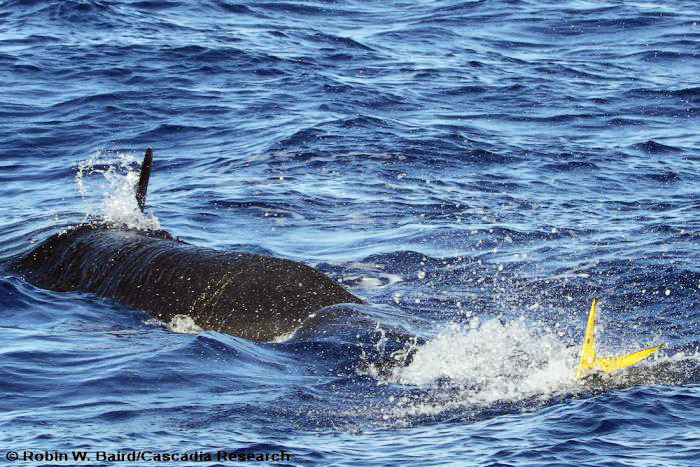
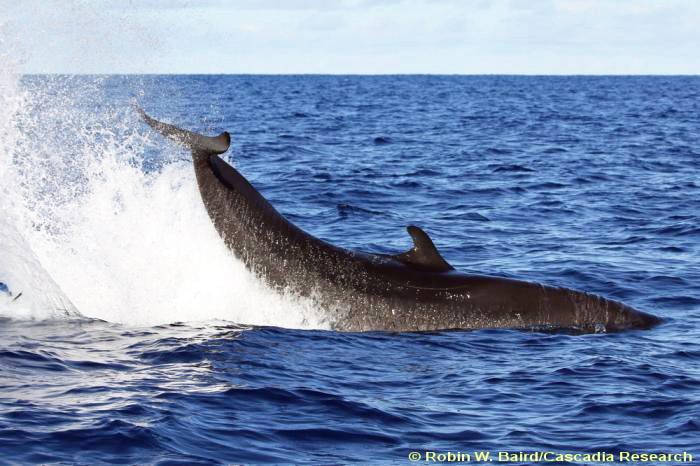
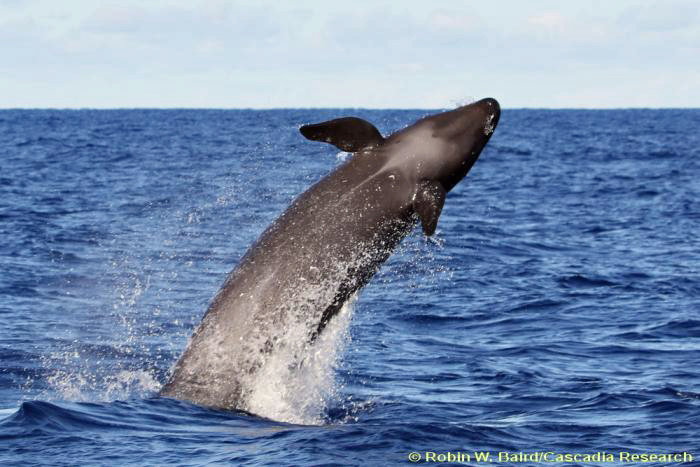
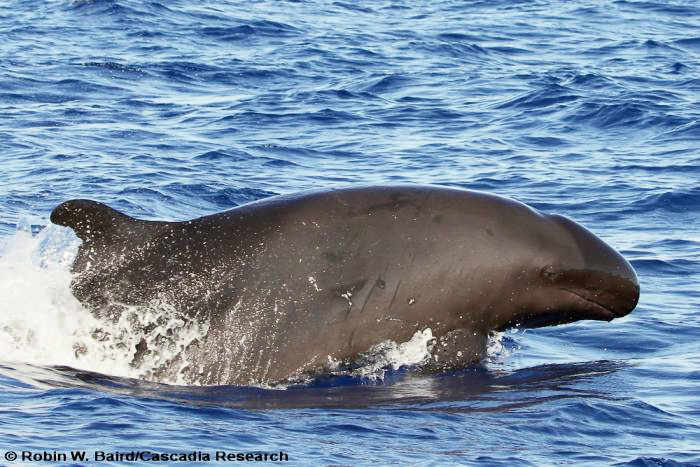
This individual is an adult male – the rostrum (melon) of older male false killer whales extends farther forward than for adult females.
November 14th update

The winds have picked up quite a bit, and while the tagged false killer whales remain offshore of Wai’anae they are in an area that is too rough to find them (or work with them), so today we searched in shallower waters. We found a large group of short-finned pilot whales, and a group of five rough-toothed dolphins that were associated with the R “FAD”. FAD is short for Fish Aggregation Device – effectively a buoy that is anchored offshore to attract small fish, which attract larger fish, and make them easier for fishermen to find (and presumably catch).

Photo (c) Robin W. Baird
While we often hear reports of rough-toothed dolphins or false killer whales associating with FADs, we don’t actually see it that often – today’s group of rough-toothed dolphins were remaining around the FAD, trying to catch fish that were sheltering underneath it.
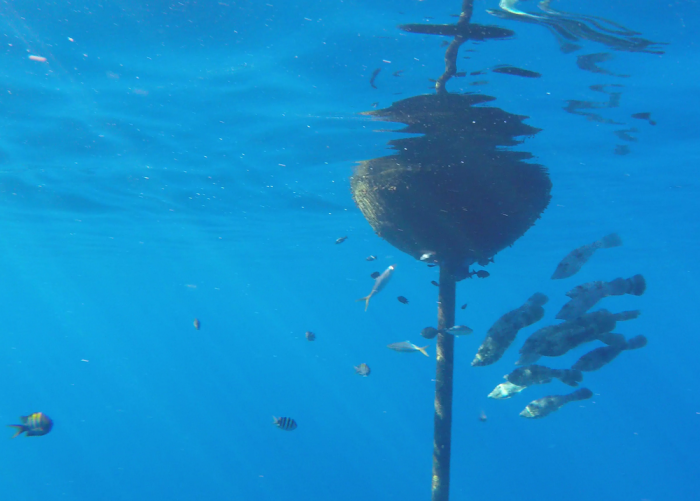
A view of the underside of the R FAD, with a school of scrawled filefish (as well as several opelu and a few other fish).
November 13th update

It has been a good few days off Wai’anae, O’ahu, with false killer whales encountered today and for the previous three days. While each day we’ve located the group with the help of the satellite tag we deployed earlier this trip, in each encounter we’ve had some individuals that we’ve not previously encountered this trip. False killer whales, like killer whales, live in very stable long-term groups, but the individuals we’ve encountered have included members of two, or perhaps even three, different social clusters (clusters 1 and 3, for those who are keeping track). This calf, HIPc697 in our photo-ID catalog, was first documented in our October 2016 O’ahu field project.
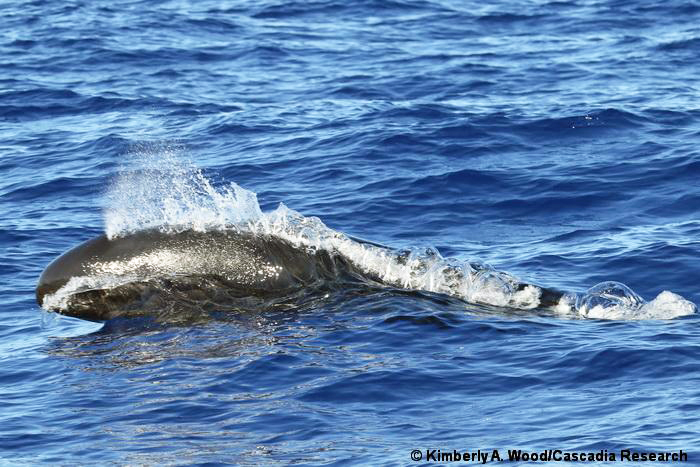
Photo (c) Kimberly A. Wood
We also encountered perhaps the most distinctive false killer whale in the population, an individual missing it’s dorsal fin. This is an adult female, first documented in 2003, and when first seen she was missing her fin, with scar tissue where the fin was, indicating the fin was lost in a traumatic event, rather than was missing as a congenital problem. This individual, along with several others, was the subject of our second-ever peer-reviewed publication on our Hawai’i work, published in 2005.
November 10th update
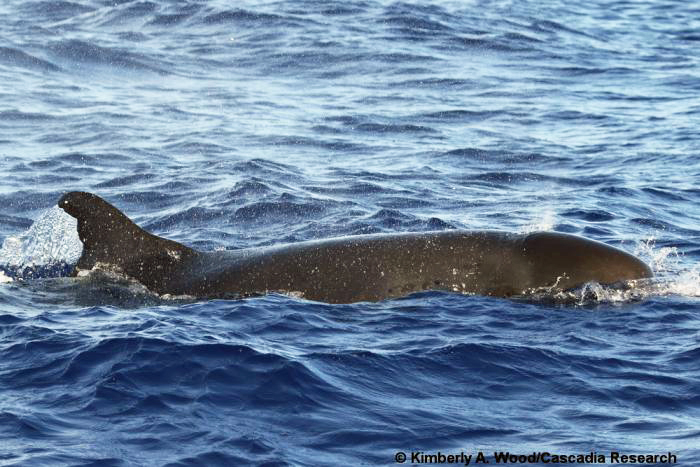
Today we had our second encounter with false killer whales for the trip! Our tagged individual had remained offshore of O’ahu in areas that we have been unable to get to, given the sea conditions, but earlier this morning the group passed through the lee off Wai’anae. We were able to catch up to the group using the signals from the tag, but they were traveling quickly and were soon in an area of rough seas again. It was a good encounter nonetheless, and we were able to get identification photos of three individuals. The individual above is HIPc204 in our photo-ID catalog, an adult male first documented in 2005.

A false killer whale traveling at high speed!
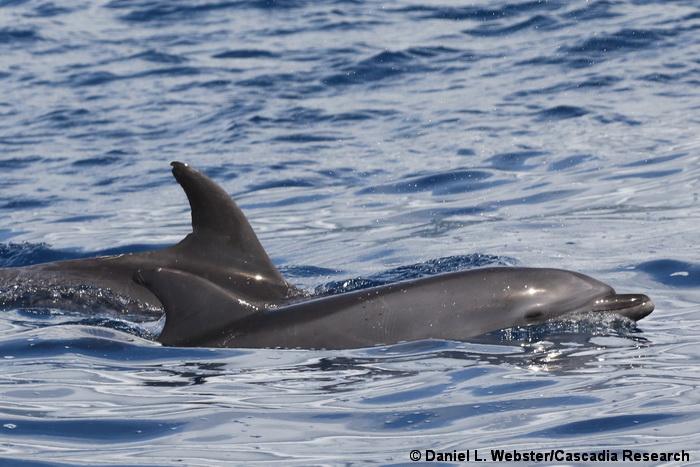
Today was our 9th day on the water and we also encountered our 9th species of odontocete for the trip, a group of almost 20 bottlenose dolphins. We were able to get good identification photos of all the individuals present for comparison to our photo-ID catalog.
November 7th update
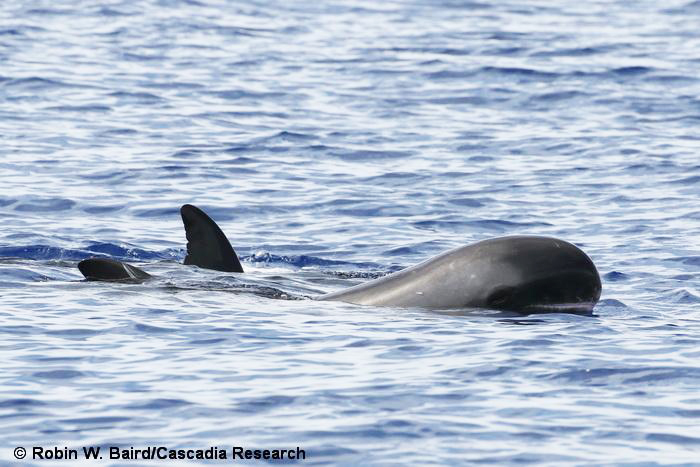
After six days on the water we’ve encountered eight species of odontocetes, including all four species of Hawaiian blackfish. Today we had two groups of pygmy killer whales, one of the least-known species of delphinids in the world. One group was 27 km from shore, while the other was just 2.6 km offshore. There is a resident population of pygmy killer whales off the island of O’ahu, and the near-shore group was probably part of the resident population. We’ll be comparing the photos to our photo-identification catalog to determine which individuals were present, and will be interested to see whether the offshore group was part of the resident population, or an unknown group from the open-ocean population.

Pygmy killer whales usually spend their day resting and socializing, often just logging at the surface, like these individuals in the nearshore group. We’ve never seen pygmy killer whales feeding in any of our encounters, so they appear to do all their foraging at night. For more information on pygmy killer whales in Hawai’i check out our web page on this species.
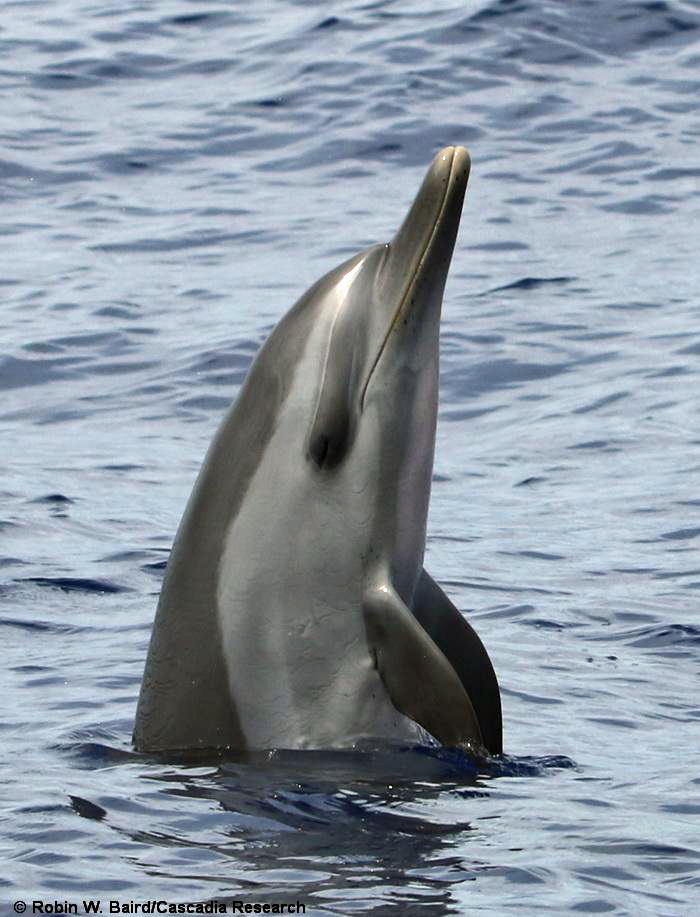
We’ve seen pantropical spotted dolphins on five of the six days we’ve been out so far – these are probably the most abundant species of dolphin around the main Hawaiian Islands. There are three insular populations recognized in Hawaiian waters, based on genetic analyses, including one around O’ahu.
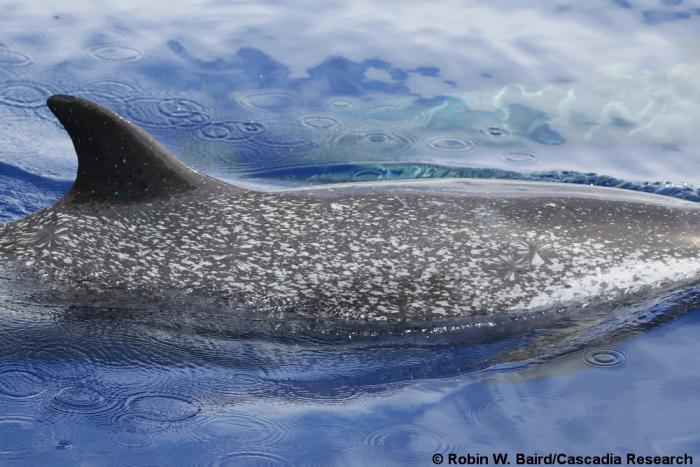
When born, pantropical spotted dolphins lack spots, and slowly acquire them with age. This individual is clearly a very old one, and likely an adult male based on size. This photo also nicely shows the starburst patterns that occur as bite wounds from cookie-cutter sharks heal, with the spots along the edges of the bite getting “dragged” inwards as the wounds heal.
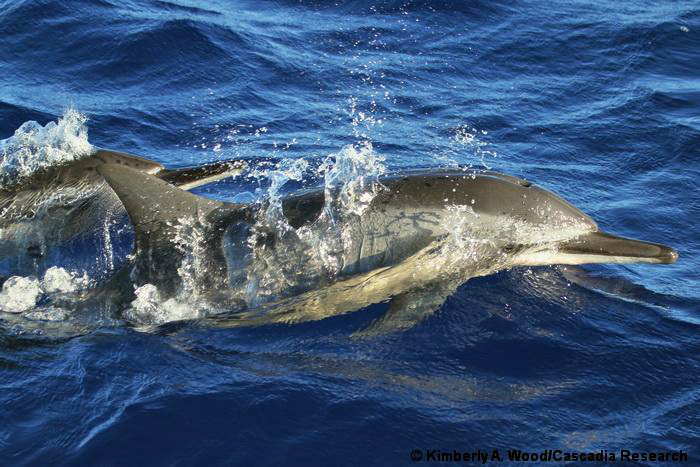
One of our most surprising encounters this trip was actually a group of spinner dolphins (yep, spinner dolphins!), a group of about 75 individuals seen offshore (in 900 m water depth) at 7:46 AM, more than an hour after sunrise. Spinner dolphins typically come into shallow water very early (around sunrise) and spend their days close to shore – in our 18 years of work in Hawai’i we rarely see spinners offshore. Seven of the eight sightings we’ve had in waters deeper than 1,000 m have been small groups (1-3 individuals) in with larger groups of pantropical spotted dolphins, and the eighth sighting offshore was a group heading out into deep water late in the afternoon. The sighting (November 6th) was only three days after the full moon, and it is known that the prey of spinner dolphins (and some other species in Hawai’i) move more offshore during a full moon, so it is likely the dolphins had farther to travel after their night of feeding.
November 4th update
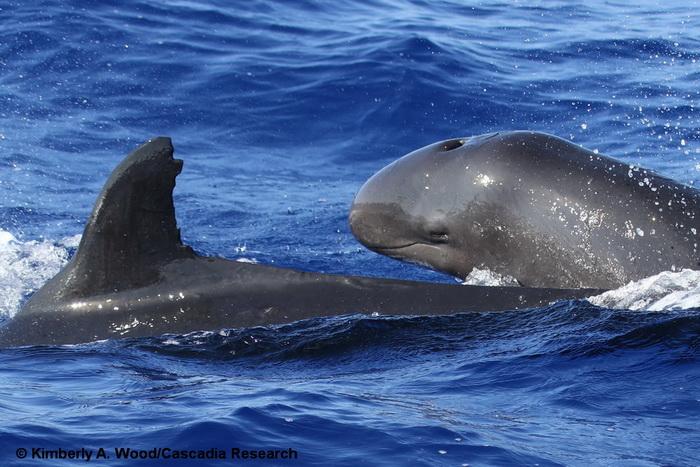
Today we encountered our highest priority species for the trip, a group of false killer whales! The adult female in the photo above is HIPc356 in our photo-ID catalog, first documented in October 2009 (off O’ahu), seen a number of times since off O’ahu and Hawai’i Island, and last seen in October 2016 (also off O’ahu). The calf in the photo, HIPc697 in our catalog, was first documented with HIPc356 in October 2016 and this is the first time the calf has been seen since it was originally documented. These individuals are most closely associated with Cluster 1 of the endangered main Hawaiian Islands population, but are part of an intermediate group that we have recently recognized (check out the poster by Sabre Mahaffy from the October Halifax marine mammal conference for more information). We were able to deploy a satellite tag on one of the individuals in the group, so are hoping to be able to track the group over the next few months.
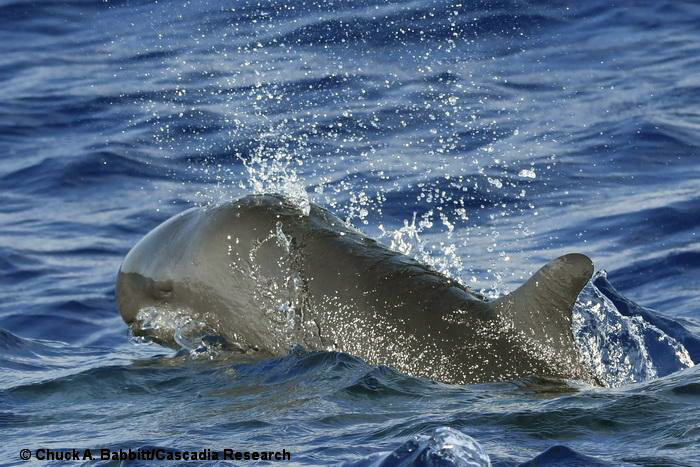
Another photo of HIPc697 – obviously well-fed, with a fat roll behind the head.

We also encountered a large group of rough-toothed dolphins, with a total of about 45 individuals, and were able to get good identification photos of many of the individuals to compare to our photo-ID catalog of this species. For more information on rough-toothed dolphins in Hawai’i check out our web page on that species.
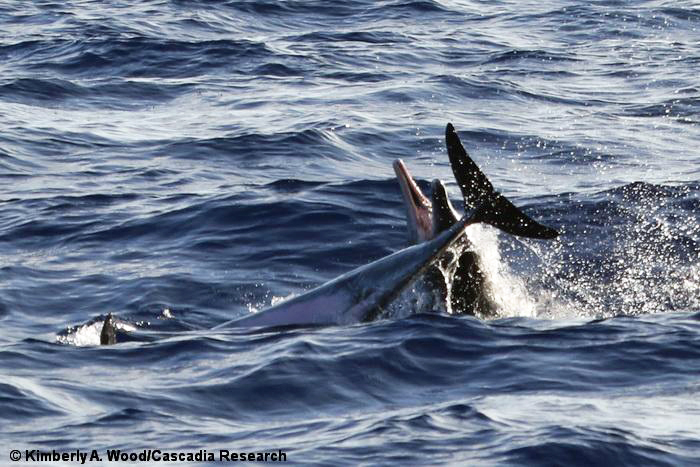
An unusual view of rough-toothed dolphins, two socializing individuals!
November 3rd update
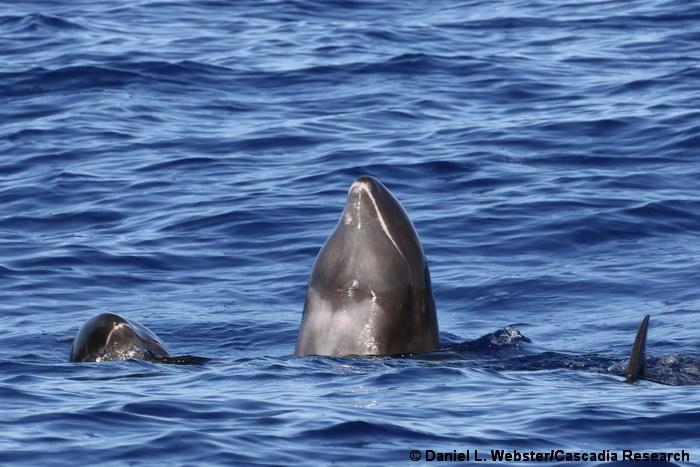
Today we found another uncommon species for O‘ahu, a group of about 450 melon-headed whales. There are two populations of melon-headed whales recognized in Hawaiian waters, a small resident population off Kohala, and a larger population that roams among the Hawaiian Islands and into offshore waters. With such a large group we took several thousand photos to compare to our photo-identification catalog. For more information on melon-headed whales in Hawaiian waters check out our web page for that species.

Photo (c) Kimberly A. Wood
Like other whales and dolphins in Hawai‘i, melon-headed whales are regularly bitten by cookie-cutter sharks, a deep-sea shark that is parasitic, not typically killing their prey. The orange color of the wound visible in this photo are actually cyamid lice (“whale lice”), which often inhabit healing wounds. This bite is in front of the eye, and will likely completely heal. In the photo below, of an older adult melon-headed whale, you can see several scars from healed cookie-cutter shark bites on the head.
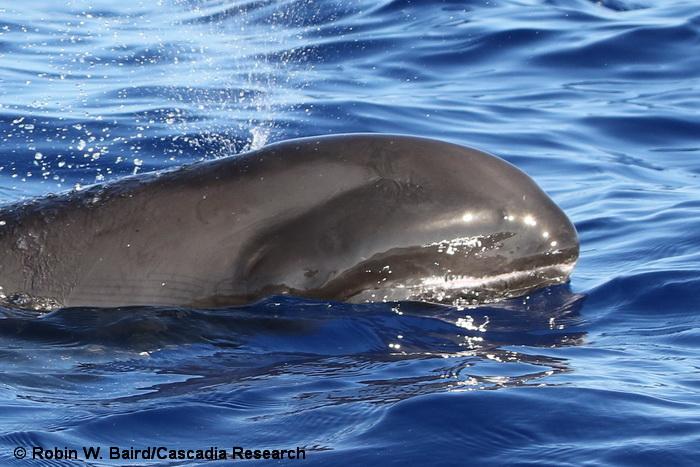
An older adult melon-headed whale, showing the characteristic white lips of the species as well as the darker facial mask.

A mother and infant melon-headed whale, seen in the group November 3rd, 2017.
November 2nd update
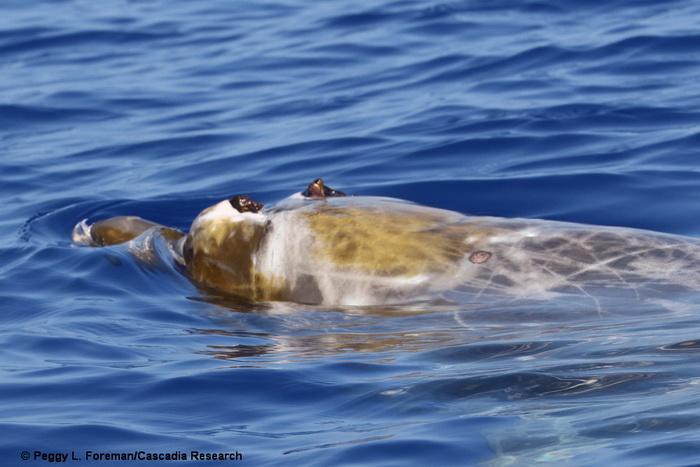
Our first day on the water was quite productive, with three encounters with short-finned pilot whales, one encounter with pantropical spotted dolphins, and two encounters with one of the less commonly-encountered species in the area, Blainville’s beaked whales! The first group encountered was a group of eight individuals, including one adult male (photo above) and three mother/calf pairs. In the photo above you can see the two erupted teeth of an adult male, with several purple stalked barnacles attached to the base of the teeth. The males use these teeth (referred to as tusks) for fighting with other adult males over access to females. We were able to get good ID photos of at least seven of the individuals, and also deployed a LIMPET satellite tag to study their movements – the first time we’ve tagged this species off O’ahu.
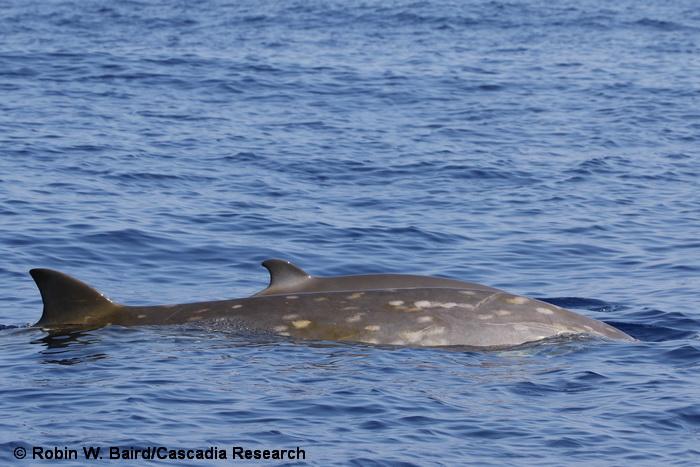
An adult female Blainville’s beaked whale with a calf, estimated at about 6 months of age. The white oval scars on the side of the body are from cookie-cutter shark bites – we use this scarring pattern, in combination with dorsal fin shape and notches, to identify individuals.
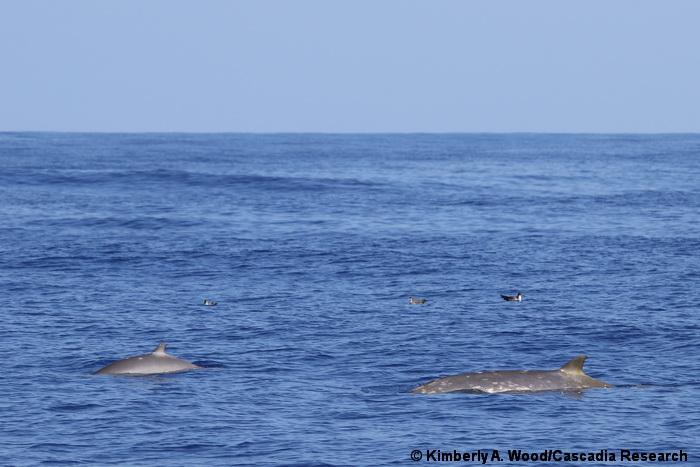
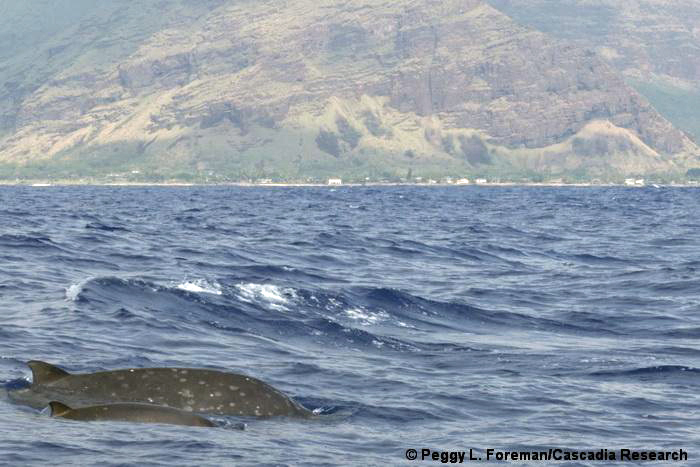
Our second sighting of Blainville’s beaked whales for the day was in much rougher seas, but we were still able to get good ID photos of all three adult females. The photo below was taken off O’ahu during our last field project there, in October 2016. We are hoping to have as much success as we did during that effort!

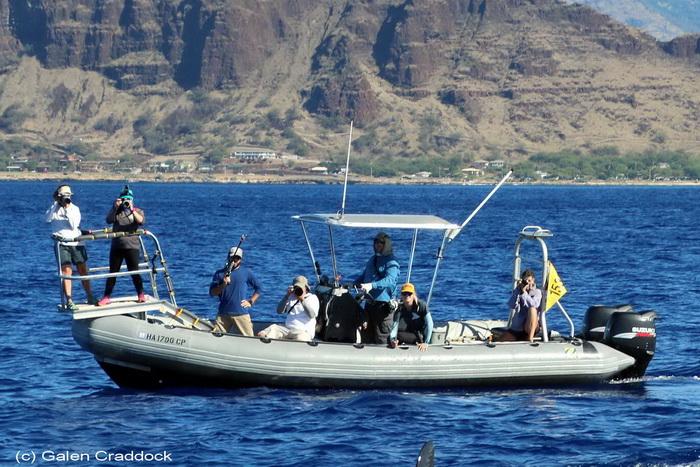
Photo (c) Galen Craddock
The research vessel we’ll be using for this project, a 24’ Hurricane.
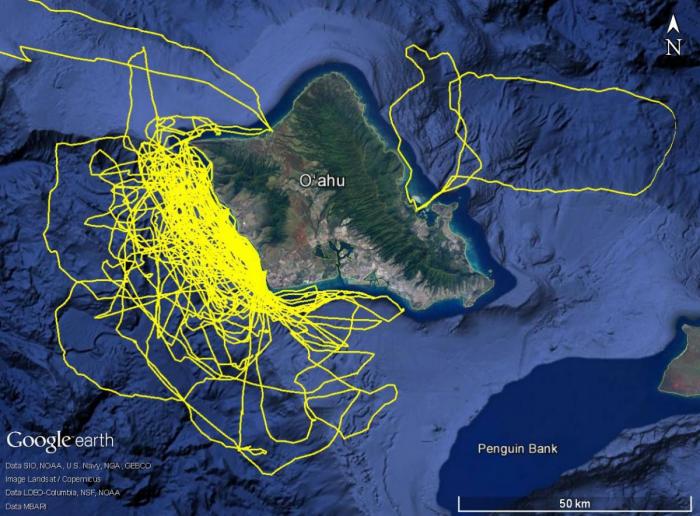
This map shows our previous search effort off O‘ahu. We worked off O‘ahu in five previous years – 2002, 2003, 2010, 2015 and 2016. Photos on this page were taken under NMFS ESA/MMPA Permit No. 20605. Please contact Robin Baird (rwbaird (at) cascadiaresearch dot org) for photo use or more information. For updates from our prior field projects check out this page.